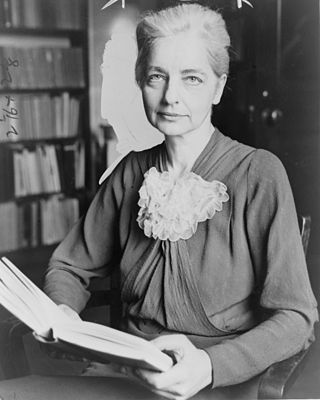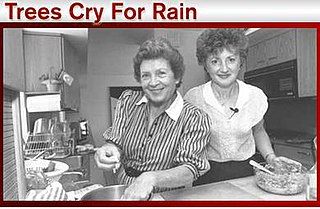
Margaret Mead was an American cultural anthropologist who featured frequently as an author and speaker in the mass media during the 1960s and the 1970s.

Ruth Fulton Benedict was an American anthropologist and folklorist.

Hortense Powdermaker was an American anthropologist best known for her ethnographic studies of African Americans in rural America and of Hollywood.

Barbara Myerhoff was an American anthropologist, filmmaker, and founder of the Center for Visual Anthropology at the University of Southern California. Throughout her career as an anthropologist, Barbara Myerhoff contributed to major methodological trends which have since become standards of social cultural anthropology. These methods include reflexivity, narrative story telling, and anthropologists' positioning as social activists, commentaries, and critics whose work extends beyond the academy.
Feminist anthropology is a four-field approach to anthropology that seeks to transform research findings, anthropological hiring practices, and the scholarly production of knowledge, using insights from feminist theory. Simultaneously, feminist anthropology challenges essentialist feminist theories developed in Europe and America. While feminists practiced cultural anthropology since its inception, it was not until the 1970s that feminist anthropology was formally recognized as a subdiscipline of anthropology. Since then, it has developed its own subsection of the American Anthropological Association – the Association for Feminist Anthropology – and its own publication, Feminist Anthropology. Their former journal Voices is now defunct.

Cora Alice Du Bois was an American cultural anthropologist and a key figure in culture and personality studies and in psychological anthropology more generally. She was Samuel Zemurray Jr. and Doris Zemurray Stone-Radcliffe Professor at Radcliffe College from 1954. After retirement from Radcliffe, she was Professor-at-large at Cornell University (1971–1976) and for one term at the University of California, San Diego (1976).
Esther Brandeau is notable in the history of the Jews in Canada as the first Jew to set foot in the country, travelling from France to New France.

In 2007 Centro Hebreo Sefaradi Synagogue was described as “…the only remaining institutional legacy of the Sephardic presence in Cuba.” Construction originally began in 1957 and the synagogue was completed in 1960 with a 726-seat sanctuary. The main sanctuary was later rented out to the Afro-Cuban band Síntesis for their rehearsals while weekly religious services were held in a small room next door. As of 2010, the synagogue had eighty families constituting 320 members. The majority of congregants were 60 or older.

Ruth Landes was an American cultural anthropologist best known for studies on the Brazilian religion of Candomblé and her published study on the topic, City of Women (1947). Landes is recognized by some as a pioneer in the study of race and gender relations.

Adio Kerida: Goodbye my Dear Love is a 2002 documentary by American anthropologist Ruth Behar that follows her trip to Cuba, which her family left when she was four. She searches for memories from her past and investigates the dwindling Sephardic Jewish community that remains, estimated at less than 800 in 2011.

Trees Cry for Rain: A Sephardic Journey is a short documentary film by American documentary filmmaker Bonnie Burt that follows "America's Internet Champion of Ladino" Rachel Amado Bortnick, as she explores her Jewish-Turkish heritage and the vanishing world of Sephardic culture and the Ladino language. The film was officially released in 1989, but drew public attention in 1992 with screenings at a number of Jewish film festivals worldwide, including the San Francisco Jewish Film Festival and the Madrid "Festival de Cine Judio" which was dubbed "the biggest Jewish cultural event held in Spain in 500 years". This was followed by a public screening at the Lincoln Center for the Performing Arts in New York, and airing on The Jewish Channel.
Behar or Bahar is a surname of Sephardic Jewish origin, thought to be an abbreviation of ben kavod rabbi, Hebrew for "a son of the honorable rabbi". Notable people with the surname include:

Moroccan Jews are Jews who live in or are from Morocco. Moroccan Jews constitute an ancient community dating to Roman times. Jews began immigrating to the region as early as 70 CE. They were later met by a second wave of migrants from the Iberian peninsula in the period which immediately preceded and followed the issuing of the 1492 Alhambra Decree, when Jews were expelled from Spain, and soon afterward, from Portugal. This second wave of immigrants changed Moroccan Jewry, which largely embraced the Andalusian Sephardic liturgy, to switch to a mostly Sephardic identity.

Smadar Lavie is a Mizrahi U.S.-Israeli anthropologist, author, and activist. She specializes in the anthropology of Egypt, Israel and Palestine, emphasizing issues of race, gender and religion. Lavie is a professor emerita of anthropology at the University of California, Davis, and a visiting scholar at the Department of Ethnic Studies, University of California, Berkeley. Lavie received her doctorate in anthropology from the University of California at Berkeley (1989) and spent nine years as assistant and associate professor of anthropology at the University of California, Davis. She authored The Poetics of Military Occupation, receiving the 1990 Honorable Mention of the Victor Turner Award for Ethnographic Writing, and Wrapped in the Flag of Israel: Mizrahi Single Mothers and Bureaucratic Torture receiving the 2015 Honorable Mention of the Association of Middle East Women's Studies Book Award Competition. Wrapped in the Flag of Israel's first edition was also one of the four finalists in the 2015 Clifford Geertz Book Award Competition of the Society for the Anthropology of Religion. She also co-edited Creativity/Anthropology and Displacement, Diaspora, and Geographies of Identity. Lavie won the American Studies Association's 2009 Gloria Anzaldúa Prize for her article, “Staying Put: Crossing the Palestine-Israel Border with Gloria Anzaldúa,” published in Anthropology and Humanism (2011). In 2013, Smadar Lavie won the “Heart at East” Honor Plaque for lifetime service to Mizraḥi communities in Israel-Palestine.

Angelina Muñiz-Huberman is a Mexican writer, academic, poet and professor. She is known for her work and research on Ladino, crypto-Judaism, Jewish mysticism and Sephardic Jews. Muñiz-Huberman is a recipient of the Xavier Villaurrutia Award and the Sor Juana Inés de la Cruz Prize. In 2022, she received an honorary doctorate from the National Autonomous University of Mexico (UNAM) for a lifetime's work, an honor she shares with such figures as John Dewey, Octavio Paz and Juan Rulfo.
Ruth Fredman Cernea was an American cultural anthropologist, who dedicated virtually all her field research and writings to the analysis of Jewish culture and symbols, in various settings.
Norma Diamond was an American anthropologist who specialized in the study of Chinese society, especially in Taiwan, and women's studies. She was Professor of Anthropology at University of Michigan from 1963 to 1996, and named Professor Emerita. She was the first woman to be a tenure track professor in Anthropology at that institution.
Jewish women in the early modern period were a crucial part to all Jewish societies, as they made up half of the population. Living in places such as Italy, Poland-Lithuania, and the Ottoman Empire had effects on the role Jewish women played in their society. Different customs and regulations were found in various societies around the world.

Women Writing Culture is a 1995 book on the role of women in anthropology, the practice of ethnographic writing, feminist anthropology, and the gender and racial politics of the canon of recognized works in anthropology. Edited by Ruth Behar and Deborah Gordon, the book collects work from female anthropologists such as Louise Lamphere, Faye V. Harrison, Lila Abu-Lughod, Catherine Lutz, Kirin Narayan, Aihwa Ong, and Anna Tsing. Women Writing Culture has been cited as part of anthropology's "literary turn" and is stated by Keridwen Luis to highlight the longstanding involvement of female ethnographers in self-reflective, experimental, collaborative and literary forms of anthropological writing, and propose "the creation of a feminist canon" in anthropology. The project emerged as a counterpoint to Writing Culture, a 1986 anthology that was a key text in the literary turn.

Sarah Abrevaya Stein is a prominent American historian of Sephardic and Mediterranean Jewries.














